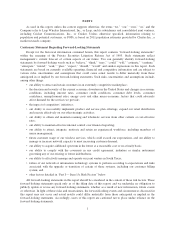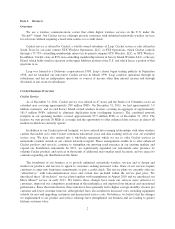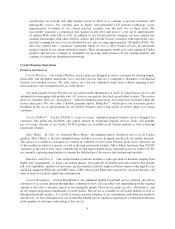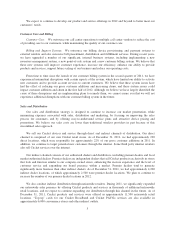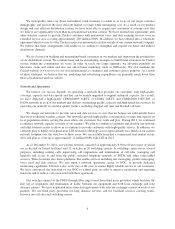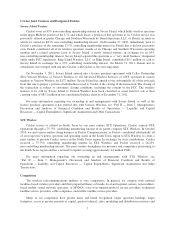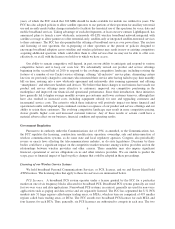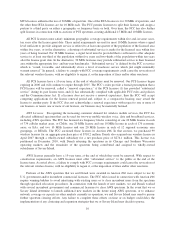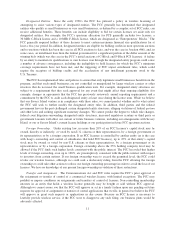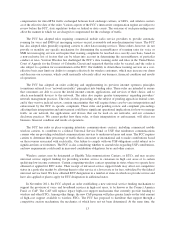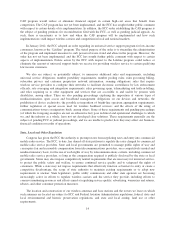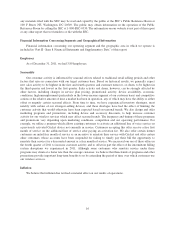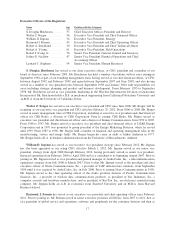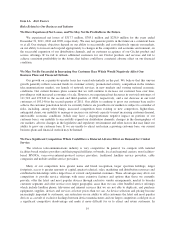Cricket Wireless 2011 Annual Report Download - page 20
Download and view the complete annual report
Please find page 20 of the 2011 Cricket Wireless annual report below. You can navigate through the pages in the report by either clicking on the pages listed below, or by using the keyword search tool below to find specific information within the annual report.MTA licenses authorize the use of 30 MHz of spectrum. One of the BTA licenses is for 30 MHz of spectrum, and
the other three BTA licenses are for 10 MHz each. The FCC permits licensees to split their licenses and assign a
portion to a third party on either a geographic or frequency basis or both. Over time, the FCC has also further
split licenses in connection with re-auctions of PCS spectrum, creating additional 15 MHz and 10 MHz licenses.
All PCS licensees must satisfy minimum geographic coverage requirements within five and, in some cases,
ten years after the license grant date. These initial requirements are met for most 10 MHz licenses when a signal
level sufficient to provide adequate service is offered to at least one-quarter of the population of the licensed area
within five years, or in the alternative, a showing of substantial service is made for the licensed area within five
years of being licensed. For 30 MHz licenses, a signal level must be provided that is sufficient to offer adequate
service to at least one-third of the population within five years and two-thirds of the population within ten years
after the license grant date. In the alternative, 30 MHz licensees may provide substantial service to their licensed
area within the appropriate five- and ten-year benchmarks. “Substantial service” is defined by the FCC as service
which is “sound, favorable, and substantially above a level of mediocre service which just might minimally
warrant renewal.” In general, a failure to comply with FCC coverage requirements could cause the revocation of
the relevant wireless license, with no eligibility to regain it, or the imposition of fines and/or other sanctions.
All PCS licenses have a 10-year term, at the end of which they must be renewed. Our PCS licenses began
expiring in 2006 and will continue to expire through 2015. The FCC’s rules provide a formal presumption that a
PCS license will be renewed, called a “renewal expectancy,” if the PCS licensee (1) has provided “substantial
service” during its past license term, and (2) has substantially complied with applicable FCC rules and policies
and the Communications Act. If a licensee does not receive a renewal expectancy, then the FCC will accept
competing applications for the license renewal period and, subject to a comparative hearing, may award the
license to another party. If the FCC does not acknowledge a renewal expectancy with respect to one or more of
our licenses, or renew one or more of our licenses, our business may be materially harmed.
AWS Licenses. Recognizing the increasing consumer demand for wireless mobile services, the FCC has
allocated additional spectrum that can be used for two-way mobile wireless voice, data and broadband services,
including AWS spectrum. The FCC has licensed six frequency blocks consisting of one 20 MHz license in each
of 734 cellular market areas, or CMAs; one 20 MHz license and one 10 MHz license in each of 176 economic
areas, or EAs; and two 10 MHz licenses and one 20 MHz license in each of 12 regional economic area
groupings, or REAGs. The FCC auctioned these licenses in Auction #66. In that auction, we purchased 99
wireless licenses for an aggregate purchase price of $710.2 million. Denali also acquired one wireless license in
April 2007 through a wholly-owned subsidiary for a net purchase price of $274.1 million. This license was
partitioned in December 2010, with Denali retaining the spectrum in its Chicago and Southern Wisconsin
operating markets and the remainder of the spectrum being contributed and assigned to wholly-owned
subsidiaries of Savary Island.
AWS licenses generally have a 15-year term, at the end of which they must be renewed. With respect to
construction requirements, an AWS licensee must offer “substantial service” to the public at the end of the
license term. As noted above, a failure to comply with FCC coverage requirements could cause the revocation of
the relevant wireless license, with no eligibility to regain it, or the imposition of fines and/or other sanctions.
Portions of the AWS spectrum that we and Denali were awarded in Auction #66 were subject to use by
U.S. government and/or incumbent commercial licensees. The FCC rules issued in connection with Auction #66
require winning bidders to avoid interfering with existing users or to clear incumbent users from the spectrum
through specified relocation procedures. In connection with the launch of new markets, we and Denali worked
with several incumbent government and commercial licensees to clear AWS spectrum. In the event that we or
Savary Island determine to launch additional new markets in the future using AWS spectrum, or to enhance
network coverage or capacity in other markets currently in operation, we and Savary Island may need to pursue
further spectrum clearing efforts. Any failure to complete these efforts on time or on budget could delay the
implementation of any clustering and expansion strategies that we or Savary Island may decide to pursue.
10



